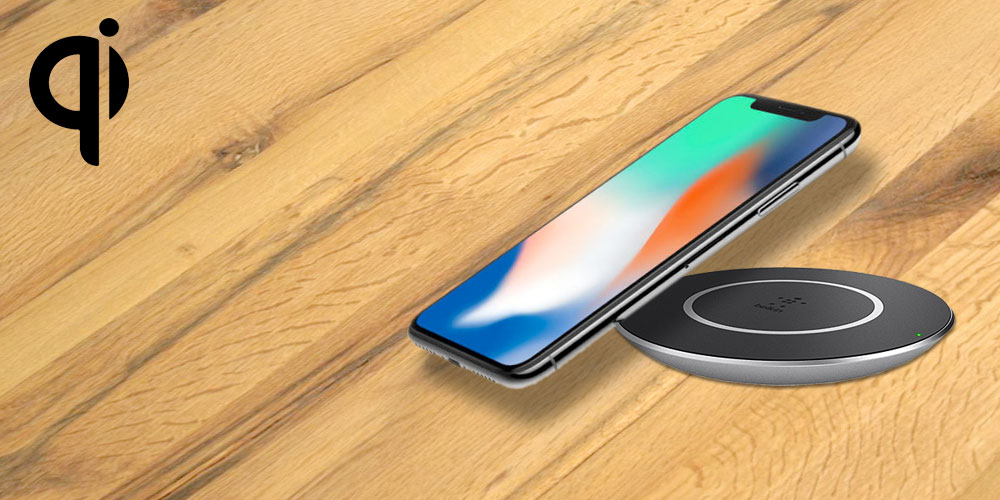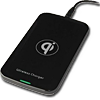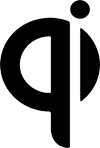Wireless charging of mobile phones

Smartphone, Tablet and Smartwatch are our daily companion today. While mobiles had power for a couple of days, smartphones might be empty in the afternoon today. Besides the network connections also the high resolution display and GPS consumes quite some power.
Every smartphone has to be recharged sooner or later to get new energy. And it is not alone as a lot of electronic devices need a charger, too. While these are kind of hidden at home or at work behind the desk one discovers on journeys what ballast has to be carried. On the other hand with network connections by LTE, WLAN or Bluetooth the cable of the charger is often the only thing hanging on the perfectly designed notebook or smartphone like a foreign object.
The
solution is actually simple. What works for the electric toothbrush should also work for the mobile
phone – inductive charging. As early as 1891 ![]() Nikola Tesla experienced with
wireless energy transfer. Besides the mentioned toothbrush the technique did not succeed for a long
time. The first system being used in mass production was the Touchstone named system in 2009 within the
Nikola Tesla experienced with
wireless energy transfer. Besides the mentioned toothbrush the technique did not succeed for a long
time. The first system being used in mass production was the Touchstone named system in 2009 within the ![]() Palm Pre. Disadvantage of this and similar solutions from third
party accessory manufacturers was that they only worked with a few devices from the same company. As
every company built these chargers differently they consisted of many ICs, an individually designed
coil, many different additional parts and an own technique to transfer the power. Except for the
integrated Palm solution the third party accessories were all thick batteries with new back cover
which did not look good on the smartphones which aimed to get thinner with each new device. Because
of the missing mass production these solutions could not be offered affordable and failed at the
consumer with prices around $100. The solution could only be an interoperable standard which would
be fully integrated and produced affordable in masses.
Palm Pre. Disadvantage of this and similar solutions from third
party accessory manufacturers was that they only worked with a few devices from the same company. As
every company built these chargers differently they consisted of many ICs, an individually designed
coil, many different additional parts and an own technique to transfer the power. Except for the
integrated Palm solution the third party accessories were all thick batteries with new back cover
which did not look good on the smartphones which aimed to get thinner with each new device. Because
of the missing mass production these solutions could not be offered affordable and failed at the
consumer with prices around $100. The solution could only be an interoperable standard which would
be fully integrated and produced affordable in masses.
The Wireless Power
Consortium (WPC) was established on 17. December 2008 and consists of over 100 members in diverse
industries, including cellular technology, consumer electronics, batteries, integrated circuits,
wireless technologies, network providers and manufacturers of furniture and car equipment. The WPC
standardized a specification called Qi and develops different wireless charging techniques.
The Standard was named after the Chinese language word Qi respectively Chee (air or
spiritual energy flow). Devices of different companies equipped with the Qi logo may now be charged
with standardized Qi chargers. As the standard is now found in many devices, the service is also
emerging in public areas (airports, hotels, cafes, restaurants, etc.) and the charger can stay at
home more and more often.
Qi uses a magnetic induction between sender and receiver. Both exchange data with 2 kilobits per
second to maintain an optimal energy transfer. The sender modulates the sending field. RFID like
technology is used by the receiver to send data to the sender. The transmitted power is 5 Watt (Low
Power) or 120 Watt (Medium Power) at a transmission frequency from 110 to 205 kHz (Long Wave).
Multi-Layer Foreign Object Detection (FOD) ensures metallic objects may be placed on the charging
pad without becoming hot due to the magnetic field. The first known Qi compatible mobile phones
were ![]() Nokia Lumia 920 and
Nokia Lumia 920 and ![]() Google Nexus 4. In 2019, the
Google Nexus 4. In 2019, the ![]() Meizu Zero was introduced as the first smartphone that had no
longer any buttons or ports and relied on Qi for charging.
Meizu Zero was introduced as the first smartphone that had no
longer any buttons or ports and relied on Qi for charging.
Qi Versions
The standard was developed as follows:
- Version 1.0
- Qi transmitter delivers 5 Watt power into a Qi phone.
- Choice of transmitter designs include single coil transmitter, coil array transmitter, and moving coil transmitter.
- High flexibility in design of Qi receivers
- Limited flexibility in the design of Qi transmitters
- Increased design freedom for transmitters. You can now choose between 12 different transmitter specifications.
- Increased sensitivity of Foreign Object Detection. This prevents heating of metal objects in the neighborhood of an active transmitter.
- The possibility to power a Qi transmitter with a USB charger.
- Fast charging. The possibility for transmitters to deliver up to 15 Watt power and the option for receivers to obtain up to 15 Watt.
- An improved thermal test for transmitters
- Improved timing requirements
- Changed limits for Foreign Object Detection improve the sensitivity.
- Charging of Qi 1.1 receivers in up to 30 mm distance
- Charging of Qi 1.2 receivers in up to 45 mm distance
- Alternate resonant charging method added
- Charging of multiple receivers with one transmitter
- Optional unique identifier for power receivers (WP-ID)
- Hardware-based authentication between transmitting and receiving equipment mandatory for power transmission above 5 W
- FOD improved
- Reclassification of applications according to performance level
- <1 W - RF
- 15 W - Low Power
- 60-300 W - Medium Power
- 2 kW - High Power
- MPP magnetically aligns transmitter and receiver (based on Apple's MagSafe technology)
- Less heat generated due to optimized alignment
- More flexible placement of devices on the charger allowed by resonant charging
- Support for simultaneous charging of multiple devices
An
example for a mobile charging pad with Qi 1.2.2 standard and up to 15 W charging power in the
Extended Power Profile is the ![]() Belkin BOOST↑UP P-F7U014.
Belkin BOOST↑UP P-F7U014.
Examples
for chargers which are integrated into furniture with Qi 1.2.2 standard and up to 15 W charging
power are ![]() Qinside Qi1015 and
Qinside Qi1015 and ![]() ZENS PuK 3.
ZENS PuK 3.
Since the ![]() iPhone 8,
iPhone 8, ![]() iPhone 8 Plus and
iPhone 8 Plus and ![]() iPhone X Apple also supports the wireless charging
standard Qi version 1.1 with up to 7.5 watts.
iPhone X Apple also supports the wireless charging
standard Qi version 1.1 with up to 7.5 watts.
Besides
Qi there is another standard from the AirFuel Alliance which resulted from a merger of
Duracell founded Power Matters Alliance (PMA) with its standard PowerMat and the
Alliance for Wireless Power (A4WP) in mid 2015. The first two smartphones with built in
PowerMat were the ![]() Samsung Galaxy S6 and
Samsung Galaxy S6 and ![]() Samsung Galaxy S6 Edge which both feature Qi in
addition. PowerMat has the benefits of being able to charge multiple devices and this with higher
power. However, Qi is found in more smartphones today than PowerMat and even Ikea already sells
furniture with built in Qi chargers. The AirFuel Alliance also realized this early in 2018
and joined the WPC.
Samsung Galaxy S6 Edge which both feature Qi in
addition. PowerMat has the benefits of being able to charge multiple devices and this with higher
power. However, Qi is found in more smartphones today than PowerMat and even Ikea already sells
furniture with built in Qi chargers. The AirFuel Alliance also realized this early in 2018
and joined the WPC.









